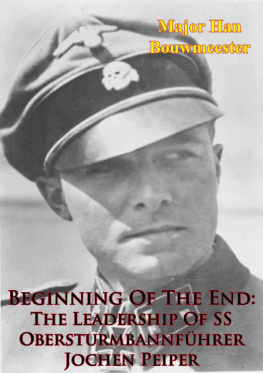Table of Contents
For Sarah and Wade
ACKNOWLEDGMENTS
This book emerged from a larger seventeen-year project on the life and times of Jochen Peiper. However, after reviewing the mass of writing, my editor, Bob Pigeon, realized that we had a separate and very dramatic story of the Malmdy massacreand one not completely told.
Special thanks to Will C. C. Cavanagh, an English subject at the time living in Waimes, Belgium, who helped me over a two-year period to interview many civilian witnesses in the Ardennes. The many Belgians who thoughtfully invited us into their homes to relive disturbing events touched us deeply. In particular, my discussions with Robert Pfeiffer and Peter Lentz were vitally important, as both boysnow menwere witnesses to the massacre and its aftermath. Other local interviews for which I am thankful include Joseph Dejardin, Joseph Pothen, Armand Reutsch, Marthe and Ida Martin, and Madeleine Warand-Lejoly. In La Gleize, Gerard Gregoire and his daughter Marie France suggested contacts, and Erik Wuite helped with one last-minute interview. I also appreciate the warm welcome from Marcel and Mathilde Schmetz at the Remember Museum as well as their willingness to search out local information.
I am particularly indebted to John Bauserman, whose book on the Malmdy massacre remains a singular accomplishment. Over the long gestation of my work John always helped with sources and his own personal interviews as well as to examine the mass of evidence from the tragic and deeply complicated sequence of events at Baugnez. Also, George Gaadt, who knows the Malmdy story intimately, has been of considerable help and has contributed maps and illustrations. Similarly, I appreciate Belgian historian Henri Rogister, whose research on the massacre supplemented my own. Dr. Donald Goldstein and the University of Pittsburgh assisted with photographic sources.
I interviewed many individuals from the 285th FAOB: Ted Paluch, Bill Summers, Bobby Werth, Al Valenzi, Tom Bacon, Stephen Domitro-vitch, Harold Billow, Warren Schmidt, George Fox, and Robert Mearig. I corresponded with several more. Their stories highlight the human spirit amid adversity. In 1999 I was able to walk with Bill Merriken and others, tracing his epic trek to escape the killing field. Sadly, Bill died before this project was complete, but here I preserve his poignant tale. In 2007 I accompanied Ted Paluch back to Baugnez in a particularly revealing odyssey. Ted and I remain good friends.
At the U.S. National Archives (NARA) I had a great deal of help. Richard Boylan, Paul Brown, Amy Schmidt, and the late John E. Taylor were instrumental in helping me over a decade to wade through the mountain of documents and papers (over thirty-eight thousand pages) dealing with the Malmdy investigation. Other thanks go to Patricia Spayd and Bill Warnock for their unselfish willingness to help at NARA. After spending many weeks in the nations capital at the archives, I am indebted to the staff and regulars at the Hotel Tabard Inn, my home away from home. There, revelry is defined.
At the U.S. Army Military History Institute I received assistance from Dr. Richard J. Sommers and David A. Keogh. I extend thanks to the late John Toland and his daughter Tamiko for making all of his private papers and taped interviews available to me at both the Franklin D. Roosevelt Library and the Library of Congress. At the latter I had assistance from Ronald E. Cogan, Jeff Flannery, and Bryan Cornell. Locally, Yayi Rickling at Brevard Community College was always of help.
In England, Gen. Michael Reynolds, the author of his own important account of the Kampfgruppe Peiper, always lent a hand when I asked. John S. D. Eisenhower graciously made available his personal papers at the Eisenhower Library as well as agreed to a pleasurable afternoon discussing his fathers remembrances of the episode. Particular note also must be made of Professor Emeritus James Weingartner at Southern Illinois University, the author of the seminal work on the trial, Crossroads of Death: The Story of the Malmdy Massacre and Trial, who shared freely from unique sources.
One person to whom I owe a heavy debt is my very professional Austrian interpreter and translator living in Washington, DC, Helmut Thiess. Together we conducted some key interviews in Germany. Helmut became a close friend, only to die tragically in the midst of the long research. I miss his wise counsel and like to think he would be proud of what he helped me create. In Germany, we were ably assisted by Dr. Jens Westemeier, who was instrumental in making many contacts and setting up interviews. We developed a real friendship over the years of work from which this book emerged. Timm Haasler and Hans Weber, experts on Kampfgruppe Peiper, helped with many details essential in piecing together the story from the German side. Finally, Mike Smeets, a Dutch historian, also shared freely from his sources and interviews.
I greatly appreciate the Waffen SS veterans who faced me with openness even when our views did not match. Hans Siptrott, Arndt Fischer, Gerhard Walla, Reinhold Kyriss, and Rolf Reiser all told stories from firsthand presence. Werner Ackermann and Manfred Thorn gave extensive interviews of their experiences in Peipers panzer regiment. Several witnesses preferred to remain anonymous; to those not mentioned I give my thanks. Thanks also to Wolf Mauder, who introduced me to several unique sources. To those on the German side, who may feel betrayed by my conclusions, I express my gratitude; Ive made a sincere effort to be objective.
I have benefited from helpful readers. Ann Hamilton Shields helped review the writing with critical comment throughout. More than this, during my last three years of work Ann became the project research assistant in Germany and contributed hundreds of selfless hours as well as interviews assisted by her husband, Mo. Moreover, her friends, Sarah and Edith, provided expert translation on short notice. Another careful reviewer was Ms. Terry Hirsch, to whom a number of corrections owe their origin.
Early on, Clyde Taylor, my literary agent with Curtis Brown Ltd., professed confidence in this project. Tragically, Clyde died suddenly in early 2001a painful loss. Fortunately, Kirsten Manges and, later, Katherine Fausset, also with Curtis Brown, stepped in to take over. At DaCapo Press, thanks to Andrea Schultz for the vision to take the project on and to Robert Pigeon, my patient editor who saw an opportunity to create a special book on Malmdy. Finally, within the closing stages, project editor Lori Hobkirk and copy editor Josephine Mariea provided much-needed polish.
At home my family has endured my years of work with this difficult subject with as much cheer and understanding as can be reasonably expected. Any writer knows that means a lot.
Danny S. Parker
Cocoa Beach, July 2011
Prisoners of War are in the power of the hostile Power, but not of individuals or corps who have captured them. They must at all times be humanely treated and protected, particularly against acts of violence, insults and public curiosity.
Article Two of the Convention Relative to the Treatment of Prisoners of War, signed July 27, 1929, at Geneva, Switzerland, by forty-six nations, of which Germany was one.














